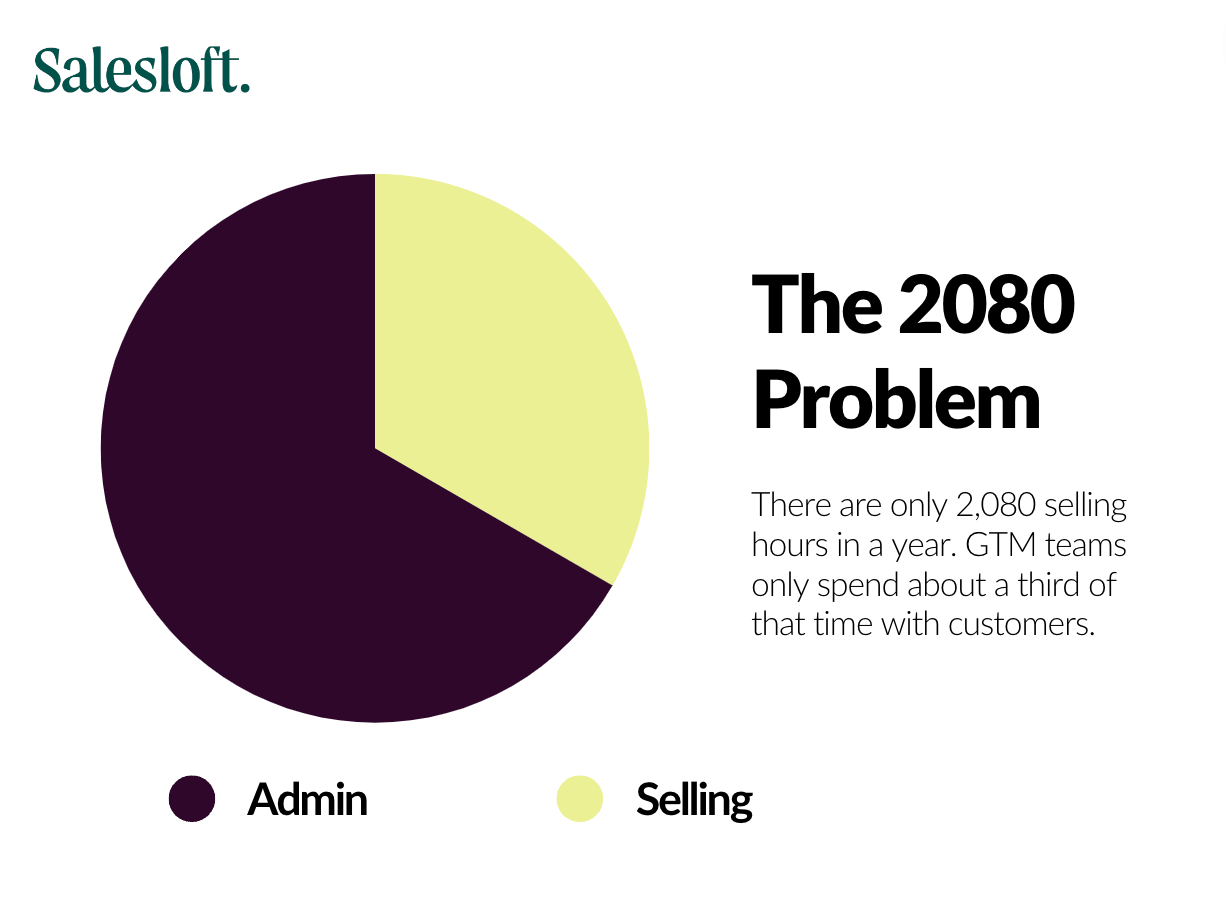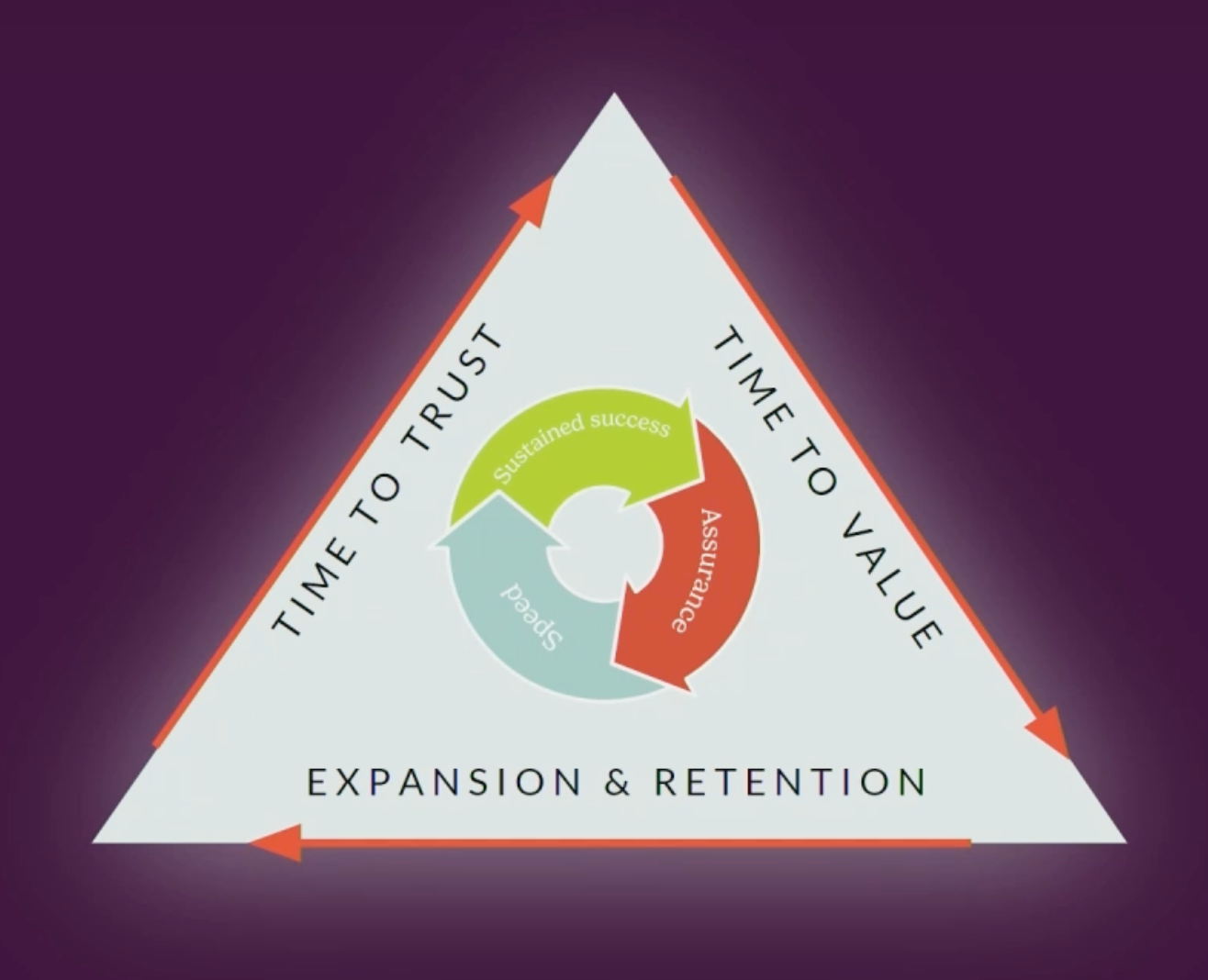“The 2080 Problem” is your biggest revenue blind spot
Updated:
Published:

2,080.
That’s how many selling hours there are in a year — and that’s not even accounting for weekends, holidays, sick days, or vacations.
Multiplied across your whole team, you might think that sounds like ample time for your reps to hit their number and gain some major wins for your sales org. But the reality for most go-to-market teams is that only about a third of that is spent engaging customers and prospects.
So what’s happening during the other two-thirds of those hours?
You guessed it: administrative work. The activities that many sales enablement systems require your reps to do — lead prioritization, conflicting KPIs, manual data entry — take up what could be valuable selling time. But it doesn’t have to be that way.

We want there to be a way to unlock more of those 2,080 hours so you can give your sellers more time to engage with prospects and customers than they ever have. And that’s what we’re doing with Salesloft Rhythm. But before we get into the solution, we have to take a look at how we built Rhythm. And we started that journey by putting ourselves both in the shoes of the buyer as well as in the shoes of the seller.
What buyers want
- Speed. As much as you don’t want your team spending hours on tasks that aren’t their main job, buyers don’t either. They have work to get back to. A speedy buying process will help them return to work faster.
- Mitigated risk. This might appear to be in direct conflict with a desire for speed, but it’s also important during the buying process. A lot of energy, research, and money is likely going into choosing a new solution for their organization. So those tangible and intangible costs need to be worthwhile.
- Enduring value. The solution they invest in should accelerate their time-to-value, helping them grow quarter over quarter. On top of growth, buyers don’t want to rethink the decision they made about a solution in a year or two. Their new technology or service should innovate faster than they are so they can use it long term.
What sellers want
- Sellers want speed, too. This is a goal that’s shared between buyers and sellers, and it makes just as much sense for sellers to want a quick process. Sales organizations need to improve cycle time and complete more deals in the same period of time.
- Maximize each transaction. While there’s a bit of conflict here between buyers wanting to mitigate risk, a seller’s job is to get the most out of every opportunity. Your reps will need to use the right balance of engagement and assessment to get your buyers to fully invest in what they’re selling.
- Customer validation. This is very similar to the growth and innovation that buyers expect to gain from a new technology. Your sellers need a large cheerleading section of customers singing their praises and touting their abilities. It’s the ultimate word of mouth and reputation building that helps sales teams continue to push your products and services to new heights.
Trust brings buyers and sellers together
The secret sauce that helps buyers and sellers converge paths starts with trust. And you have to get your potential buyers to trust the process.
As a member of a sales org, you and your team are responsible for selling your product or service thousands of times a year. Selling is where you live.
Buyers, on the other hand, are only buying from companies like yours a few times in their career. They just aren’t experts in buying, and the experience can be uncomfortable from their perspective.
Typically, buyers are going to do their due diligence and educate themselves about a new piece of technology before they ever engage with it. So if your company is being seriously evaluated by a buyer, they have to trust you already on some level. That initial trust is based on the quality of what you’ve built, how you innovate, how you treat your customers, and more.
Make sure that your company lives up to what you promote about it, and that your reviews from current customers are true and accurate. Also be open and available to prospects from the very beginning to foster even more of their trust.
Because the sooner your buyers trust the process, the faster they are to go all in with you — without smaller deal sizes or shorter contract terms.
Rhythm in the workflow builds trust faster
Here at Salesloft, we’re determined to get buyers and sellers to trust each other faster. And since we’re sellers ourselves, that meant creating technology that sped up the process, gave sellers back more of their valuable 2,080 hours, and delivered the right insights and steps to follow to deliver a better experience for buyers.
We call this maximizing “time to trust,” which is the cornerstone of a trifecta that also includes time-to-value and your expansion and retention efforts.

You can get to trust faster if you can codify your organization’s best practices and put them into a revenue workflow platform that all of your sellers can engage with and use every day.
So when we set out to create a workflow model that spans the entire go-to-market organization, we had to make sure it did all those things and more — at scale.
Even in our trials, we saw some staggering improvements because of Rhythm:
- Commercial sellers using Rhythm decreased their cycle time by 20%
- Enterprise sellers increased their average deal size by 50%
- Rhythm customers saw 23% better meeting outcomes
Within Rhythm, your sellers can see not only which actions are the most important ones to take, but also gain context on how to complete those actions, who to do them for, and when to do them. Rhythm also serves up the artifacts your sales reps need to take actions with maximum value for your customers — and your sellers’ precious 2,080 hours.
Check out our recent keynote from Saleslove on Tour in Austin for more on the 2,080 problem, Rhythm, and the future of selling.
If you’re ready to build a trusted process between your buyers and your sellers now, though, go ahead and book a demo with us today.
Recommended for you:


























